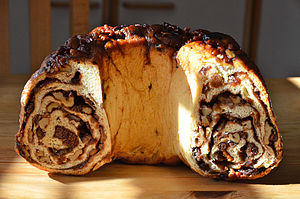Cookbook:Reindling (Austrian Yeasted Easter Cake)
| Reindling (Austrian Yeasted Easter Cake) | |
|---|---|
 | |
| Category | Pastry recipes |
| Yield | 1 reindling |
| Difficulty | |
Cookbook | Recipes | Ingredients | Equipment | Techniques | Cookbook Disambiguation Pages | Recipes | Austrian Cuisine
Reindling is a traditional pastry from Carinthia, southern Austria. Originally, it was served on festive days like weddings, baptisms or religious holidays (especially on Easter). It still plays a major role in Carinthian custom, but today there is no need to wait for a special occasion to enjoy a reindling—it has become a common dish of Carinthian cuisine.
Reindling lies somewhere between cake and white bread. It tastes delicious with butter and jam, but was also traditionally served like bread, especially with the traditional Carinthian Easter meal of ham, smoked sausages, and eggs. Some families even have two Reindlings on Easter Sunday: one simple Reindling with just a little not-too-sweet filling to balance the salty flavours of the ham and the sausages; and another one, full of fat, full of sugar and full of sweet, sticky filling, topped with butter to give the cake a deliciously crunchy surface.
There are lots of variations to the 'classic' Reindling recipe. Some people add rum to the filling or use cocoa powder instead of cinnamon. You just have to master the basic recipe and can then try experimenting with different variations. Traditionally, the cake is baked in a reindl (this is also where its name comes from), which is a flat round or square cake pan, often with a Christian symbol engraved at the bottom. However, if you cannot get hold of an authentic reindl, a bundt cake pan will also do the job.
The original recipe contributor tells the following anecdote:
"Personally, I prefer the [sweet] variety, since it reminds me of the Reindlings of my childhood. At Easter, my godmother used to bake the most scrumptious Reindlings of all time. Their exquisite smell, the rich golden brown colour of the surface, and the luscious texture of the cakes were like a foretaste, which the actual taste of the Reindling always kept. Her Reindlings were always of the sweet variety, never anything as mundane as the no-nonsense, low sugar, no nuts cakes my mother habitually baked for Easter lunch. When I was a child, the Reindling for me, was the most important thing about Easter—more important than the bonfires, more important than the egg and spoon races my cousins and I would have, and even more important than the loads of sweets my grandparents would give me. The Reindling was what it was all about, and even today I am still delighted whenever I am offererd a piece of this very special cake, be it simple or elaborate."
Ingredients
[edit | edit source]Dough
[edit | edit source]- 2 ¼ cups (500 g) all-purpose flour
- 5 tsp (40 g) yeast
- 1 ½ cup milk
- 2 eggs
- ⅓–½ cup (70–90 g) white sugar (depending on taste)
- 1 generous pinch of salt
- 8 tbsp (120 g) butter
Filling
[edit | edit source]- 5 tbsp (50 g) butter
- ½ cup (100 g) white sugar
- 1 tbsp cinnamon
- ½ cup (100 g) raisins
- ½ cup (100 g) finely-ground nuts (optional)
Topping
[edit | edit source]- 4 tbsp (60 g) of butter, chopped, for topping
Procedure
[edit | edit source]- Mix the flour with the yeast, and add a dash of the milk and sugar so that you get a smooth mixture.
- Cover it with a piece of cloth and let it rest in a warm place for half an hour.
- Add the rest of the milk and the sugar, the eggs, the butter, and salt. Work it into a smooth dough.
- Let it rest for 10 minutes. Roll out the dough so that it is roughly as thick as your thumb.
- For the filling, melt the butter and spread it on the dough.
- Mix the sugar with the cinnamon, and sprinkle this over the dough. Then add the raisins and nuts.
- Roll the dough up tightly and put it into a greased cake pan. Again, let it rest for 20 minutes.
- Finally, sprinkle little bits of butter on the cake. Then put it in the oven to bake for 50–60 minutes at about 180°C.
- When it is done, take it out of the oven and let it cool. Only when it is completely cold turn the cake out of the pan—otherwise it will break.
